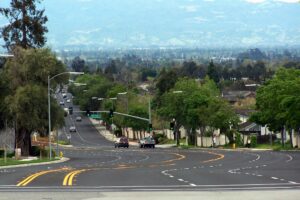If you have ever been out for a stroll in your flip-flops and stubbed a toe on a cracked sidewalk that resembles a mogul run, you will appreciate the dream that Richard Valeriano had one night. As senior public works inspector for the city of Santa Monica, he spent his days staring at sidewalks tilted at dangerous angles by growing tree roots. In his night-time dream, he saw rubber sidewalks undulating smoothly as if across ocean waves.
The dream became a reality with the help of various partnerships, and today more than 60 cities in North America are graced with pavers from Rubbersidewalks, Inc., in Gardena, California. The rubber pavers are manufactured in California and shipped to the building sites. They are then laid down over a bed of crushed granite and connected by an interlocking system of dowels. The pavers can be easily cut to fit at the site, and if any are damaged, the dowels are unlocked, and a new paver is inserted.
The rubber pavers can be draped over bumpy tree roots and still maintain a smooth, safe walking surface. The alternative in many cities is to cut down the trees with the offending roots, leaving carefully landscaped and shady streets barren of vegetation. The value of big old trees far exceeds that of the more expensive rubber pavers for most people who live on or walk those streets.
While there is no shortage of raw material as Americans discard 290 million tires a year, the pavers are still two to three times more expensive than concrete. On the other hand, city officials can appreciate the higher cost of the pavers when faced with losing mature trees, replacing buckled concrete, and dealing with expensive lawsuits related to falls on cracked concrete sidewalks.
The demand for this new material continues to grow, and Rubbersidewalks plans to open a second factory in Lockport, New York, this fall, thus reducing shipping costs to East Coast sites. It appears that a new era is dawning in the world of sidewalks. Americans can look forward to fewer stubbed toes, skinned knees, and even broken bones as rubber pavers spread through our neighborhoods.
 Christian Science Monitor
Christian Science Monitor



